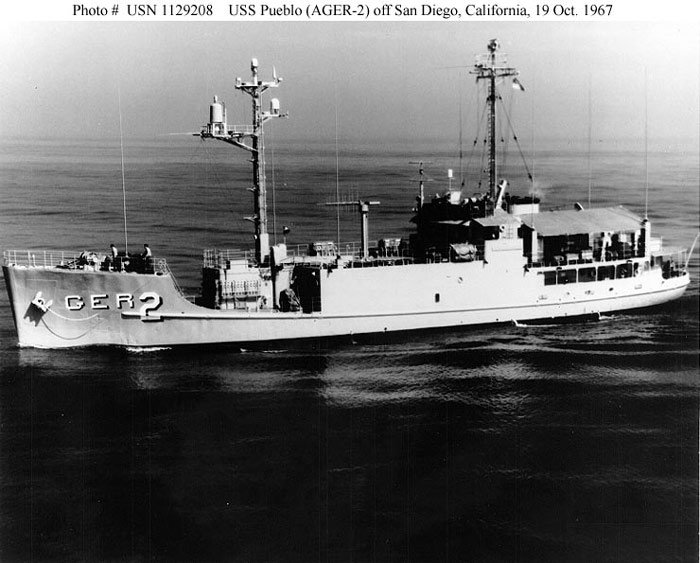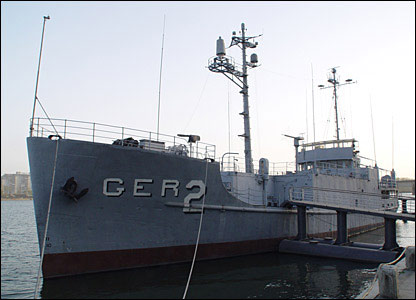THE PUEBLO INCIDENT
This Is The Most Embarrassing Incident Ever Suffered By The U.S. - Page 1
USS Pueblo (AGER-2) is a Banner-class technical research ship which was boarded and captured
by the Democratic People's Republic of Korea (North Korea) on 23 January 1968 in what is known as the Pueblo
incident or alternatively as the Pueblo crisis. This incident is the most embarrassing situation ever faced
by our military. The electronic spy equipment was supposed to be destroyed, not captured by a second rate
country such as North Korea. Our Government has covered this up as much as possible, but even today only
a very few know that it is used, of all things, as a tourist attraction. What an insult that time after
time we are made to look so foolish. The Cole incident and many others make the U.S. look like a bunch of
amateurs, the most embarrassing part of all of these occurences is that we never do anything about it. DPRK stated that she strayed into their territorial waters, but the United States maintains
that the vessel was in international waters at the time of the incident. More recently, facts have come
to light that indicate that USS Pueblo was captured by North Korea at the instigation of the Soviet Union,
which was seeking a cryptographic machine onboard to match with a key provided to the Soviets by the spy
John Anthony Walker
USS Pueblo, still held by DPRK today, remains a commissioned vessel of the United States Navy. North Korean leader Kim Jong Il has specified that it be used to promote anti-Americanism.
Initial operations
The ship was launched at the Kewaunee Shipbuilding and Engineering Company in Kewaunee, Wisconsin, on 16 April 1944 as United States Army cargo ship FS-344. She was transferred to the United States Navy in 1966 and was renamed USS Pueblo. Initially, she served as a light cargo ship, AKL-44, but shortly after resuming service was converted to an intelligence gathering ship, or what is colloquially known as a spy ship, and re-designated AGER-2 on 13 May 1967. AGER (Auxiliary General Environmental Research) denoted a joint Naval and National Security Agency (NSA) program.
Activity and conflict near the DPRK
On January 5, 1968, Pueblo left for Sasebo, Japan. She left Sasebo on January 11 with specific orders to intercept and conduct surveillance of Soviet naval activity in the Tsushima Straits and to gather signal and electronic intelligence from the Democratic Peoples Republic of Korea.
On January 21 a modified Soviet style sub chaser, SO-I class, passed within two miles (4 km) of the Pueblo.
The next day, two DPRK fishing trawlers (Lenta Class) passed within 25 yards of Pueblo. That day, a North Korean unit made an assassination attempt against South Korean leadership targets, but the crew of Pueblo was not informed.


USS PUEBLO PYONGYANG
According to the American account, the following day, January 23, Pueblo was approached by a sub chaser and her nationality was challenged, Pueblo responded by raising the US flag. The DPRK vessel then ordered her to stand down or be fired upon. Pueblo attempted to maneuver away, but was considerably slower than the sub chaser. Additionally, three torpedo boats appeared on the horizon and then joined in the chase and subsequent attack. The attackers were soon joined by two MiG-21 fighters. A fourth torpedo boat and a second sub chaser appeared on the horizon a short time later. The ammunition on Pueblo was stored below decks, and her machine guns were wrapped in cold-weather tarpaulins. The machine guns were unmanned, and no attempt was made to man them.
US Naval authorities and the crew of the Pueblo insist that before the capture, Pueblo was miles outside North Korean territorial waters; the Koreans claim the vessel was well within the DPRK's territory. The mission statement allowed her to approach within a nautical mile (1.852 km) of that limit. The DPRK, however, claims a 50-nautical-mile sea boundary even though international standards are 12 nautical miles.
The North Korean vessels attempted to board Pueblo, but she maneuvered to prevent this and a sub chaser opened fire with a 55 mm cannon. The smaller vessels fired machine guns into Pueblo, which then signaled compliance and began destroying sensitive material. The volume of material on board was so great it made it impossible to destroy all of it.
Radio contact with Naval Security Group in Kamiseya, Japan had been ongoing. Seventh Fleet command was aware of Pueblo's situation. Help was promised but never arrived. More than likely, no one wanted to take responsibility for an attack on North Korean vessels attacking Pueblo. By the time President Lyndon Johnson was awakened, Pueblo had been captured and any rescue attempt would be futile.
Pueblo followed the North Korean vessels as ordered, but then stopped immediately outside North Korean waters. She was again fired upon, and a US sailor, Fireman Apprentice Duane Hodges, was killed. She was boarded by men from a torpedo boat and a sub chaser. Crew members had their hands tied, were blindfolded, beaten, and prodded with bayonets.
Once Pueblo was in North Korean territorial waters, she was boarded again, this time by high-ranking North Korean officials.
| next page >> |